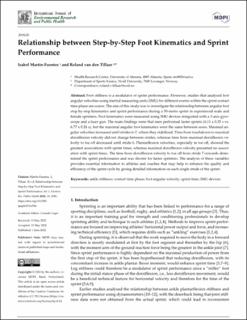Relationship between step-by-step foot kinematics and sprint performance
Peer reviewed, Journal article
Published version
Permanent lenke
https://hdl.handle.net/11250/3050409Utgivelsesdato
2022Metadata
Vis full innførselSamlinger
Originalversjon
Martín-Fuentes, I. & van den Tillaar, R. (2022). Relationship between step-by-step foot kinematics and sprint performance. International Journal of Environmental Research and Public Health, 19(11), Article 6786. doi: 10.3390/ijerph19116786Sammendrag
Foot stiffness is a modulator of sprint performance. However, studies that analysed foot angular velocities using inertial measuring units (IMU) for different events within the sprint contact time phase are scarce. The aim of this study was to investigate the relationship between angular foot step-by-step kinematics and sprint performance during a 50-metre sprint in experienced male and female sprinters. Foot kinematics were measured using IMU devices integrated with a 3-axis gyroscope and a laser gun. The main findings were that men performed faster sprints (6.11 ± 0.35 s vs. 6.77 ± 0.24 s), but the maximal angular foot kinematics were the same between sexes. Maximal angular velocities increased until strides 6–7, where they stabilized. Time from touchdown to maximal dorsiflexion velocity did not change between strides, whereas time from maximal dorsiflexion velocity to toe off decreased until stride 6. Plantarflexion velocities, especially in toe off, showed the greatest associations with sprint times, whereas maximal dorsiflexion velocity presented no association with sprint times. The time from dorsiflexion velocity to toe off from stride 7 onwards determined the sprint performance and was shorter for faster sprinters. The analysis of these variables provides essential information to athletes and coaches that may help to enhance the quality and efficiency of the sprint cycle by giving detailed information on each single stride of the sprint.

